Abstract art can be difficult to define, but we know it when we see it. Abstract art is, well, abstract.
Scholars largely agree abstract art is about visually moving away from an exact likeness of a person, place or thing. The artist doesn’t seek to replicate, as with a photo. Instead, the artist distorts, rearranges or otherwise modifies design elements such as shape, form, colour and line. Our brains then attempt to fill in the blanks of what’s exaggerated or missing. And that’s why we all experience abstract art in different ways.
The diversity of materials and techniques in abstract art is immense, and the textile art world is no exception. We’re excited to introduce you to a variety of artists who push the boundaries, including Jamele Wright, Sr., and Zipporah Camille Thomas who create cultural connections with their art. Richard McVetis creates sculptural work that captures time and space, while Kim McCormack takes us on a trek through abstract fields and puddles in the Scottish Highlands. Deidre Adams’s work purposely builds up and tears down layers of fabric and paper, and Emily Feldmann takes needle in hand to celebrate the line. Harriett Chapman rounds out our tour with abstracted everyday objects that are filled with colour and pattern.
These artists use a variety of techniques, including hand stitch, collage, botanical dyeing, painting, weaving, machine stitch and more. Step into this textile art world in which reality is subjective, and ultimately, up to you to define.
Kim McCormack
Daily walks in stitch
Kim McCormack’s abstract landscapes are as intricately layered as a forest floor. Not only does her work capture the changing terrain of her daily walks in the Scottish Highlands, but she also literally infuses the flora she gathers along the way through botanical printing.
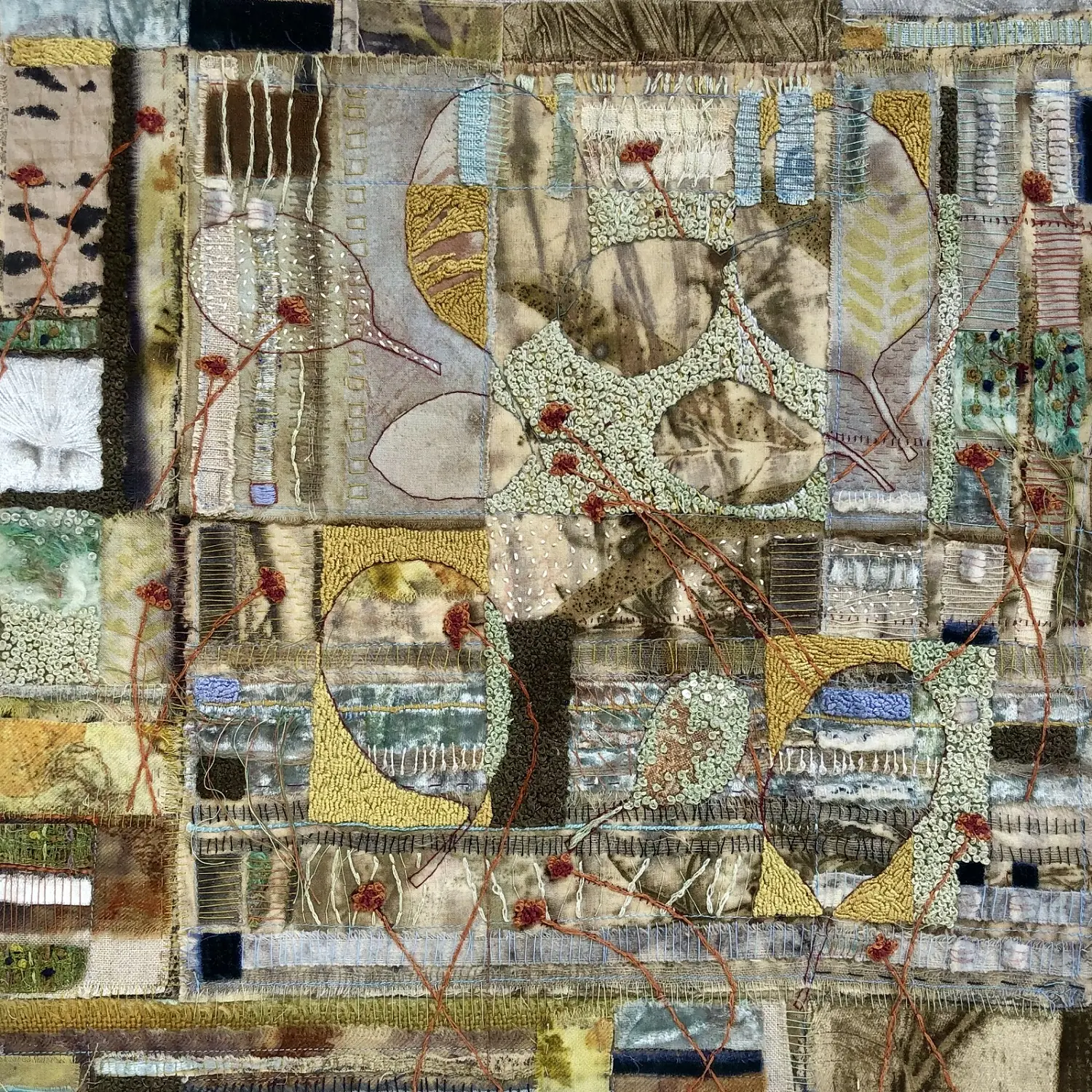
This piece was inspired by a frosty late winter day on a narrow trail dotted with melting icy puddles. Kim captures the matt of the leaves against the sheen of the reflections signalling spring was on its way.
‘The sun was out, and the sparkling puddles reflected the sky and trees as leaves were finally freed from their frozen stillness.’
Kim uses leaves, twigs, stones, lichens, pods and more for her ‘eco printing’ process. Plant materials are bundled inside wool or silk cloth and then steamed or boiled to release the plants’ dyes. The contact prints reveal the shapes of leaves, flowers or whatever plants are used.
‘The botanical imprints behave like fossilised memories of my walks—captured moments in time.’
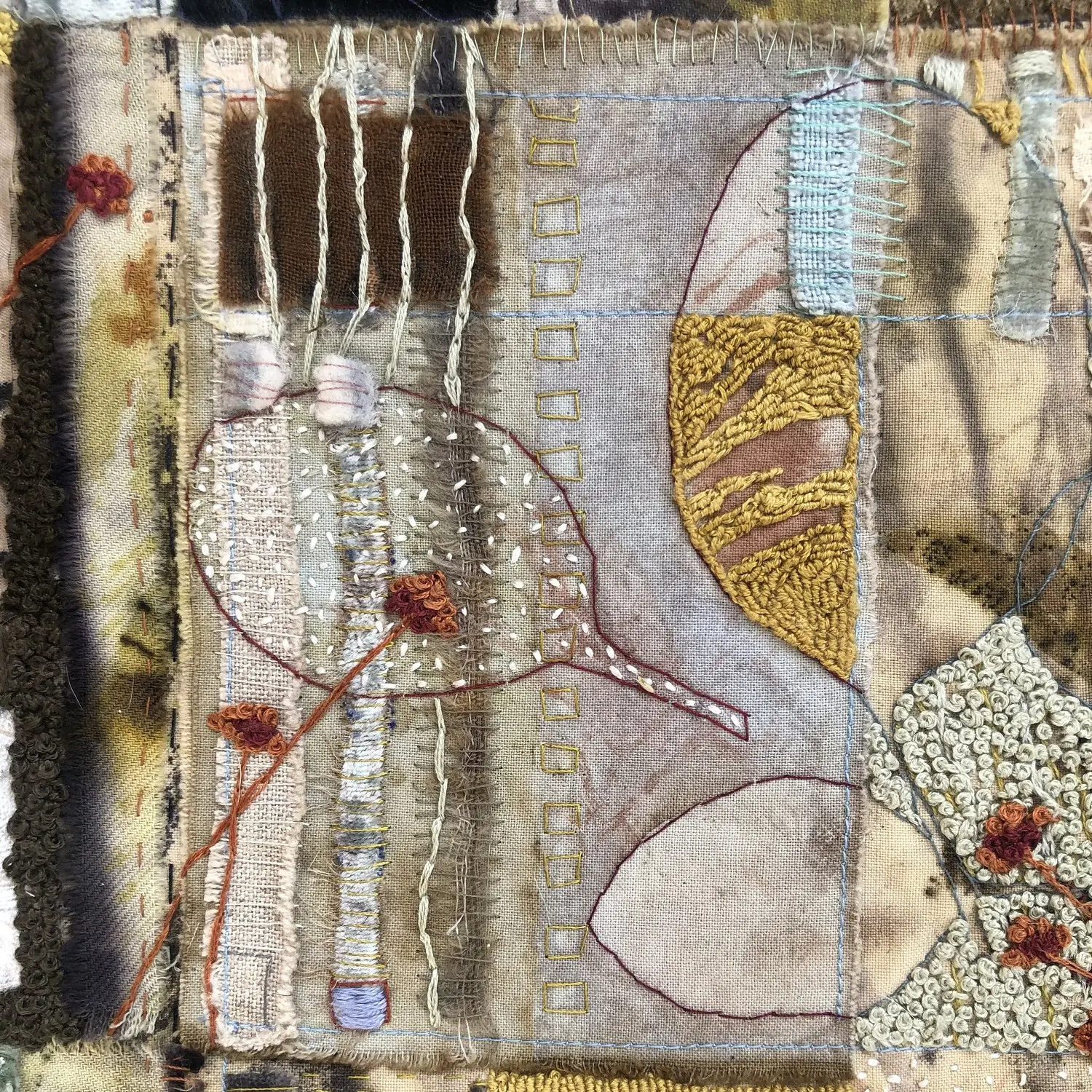
Kim then collages the printed fabrics into a grid-like layout to reflect the trails, fences and lichen-covered stone walls seen on her walks. Abstraction comes to life by her merging multiple viewpoints onto one surface. Distant stands of trees perfectly collide with nearby hogweed, which then bumps into a close inspection of moss, all in one work.
Hand embroidery with threads, string and wool is then added to create surface detail. Kim’s preferred stitch techniques include couching, running stitch, bullion and French knots.
‘The stitchwork echoes my steps along forest trails and is equally calming and therapeutic. The stitches take me back to the place.’
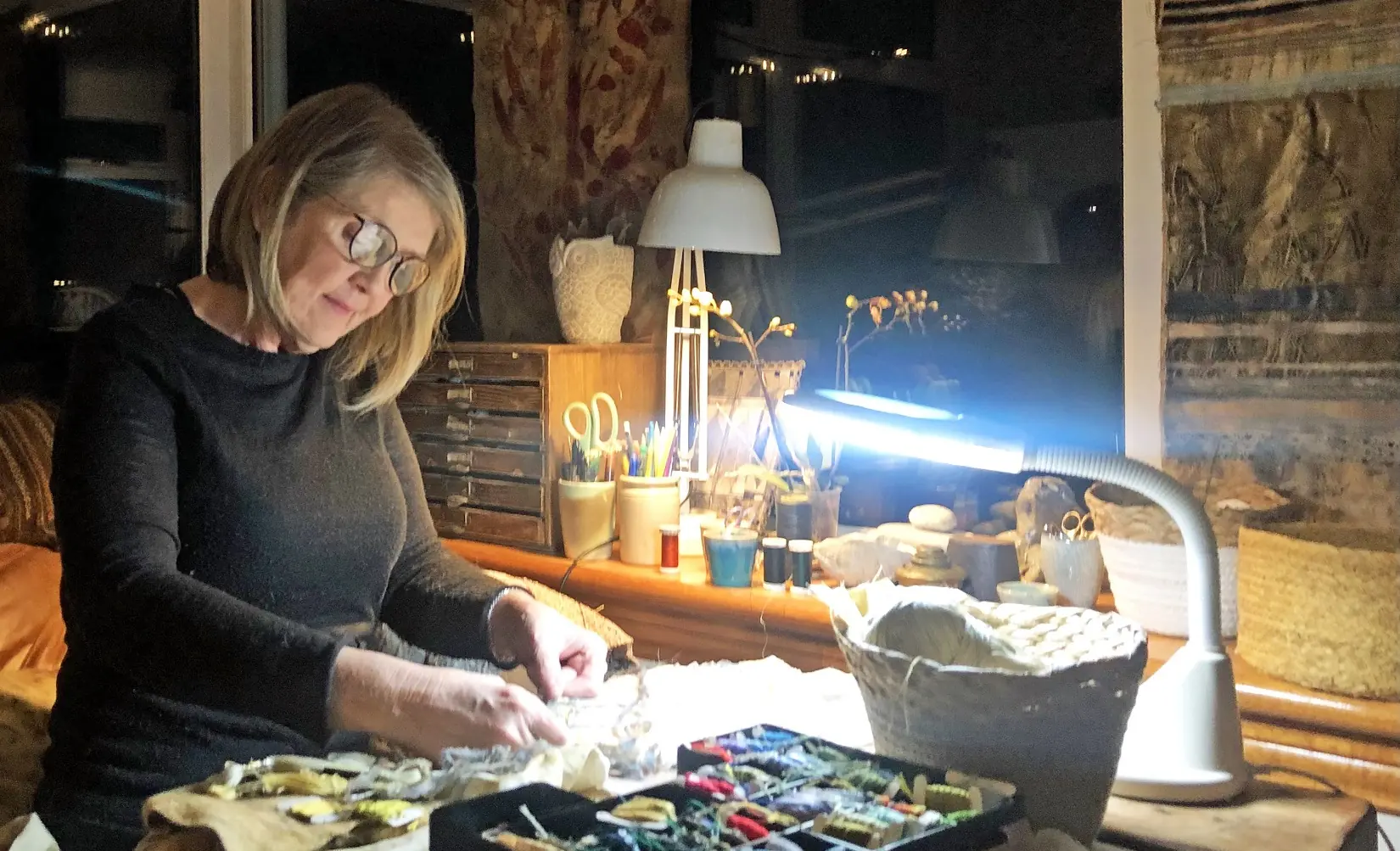
Kim McCormack is passionate about sensitively gathering foliage and printing onto recycled or ethically sourced fabrics. She also networks with botanical printers across the globe to share ideas and processes, as well as to discuss environmental issues. Kim recently joined and exhibited with PRISM Textiles and is a member of EDGE textile artists in Scotland.
Website: kimberleymactextiles.co.uk
Instagram: @kimberleymactextiles
Jamele Wright, Sr.
Connected cloth
Jamele Wright Sr. had been experimenting with ways to drape his art on walls. But true inspiration came after watching the American TV show Project Runway with his daughters. He was intrigued by the way overlapping fabric patterns shifted, broke and created new patterns when moving on the runway.
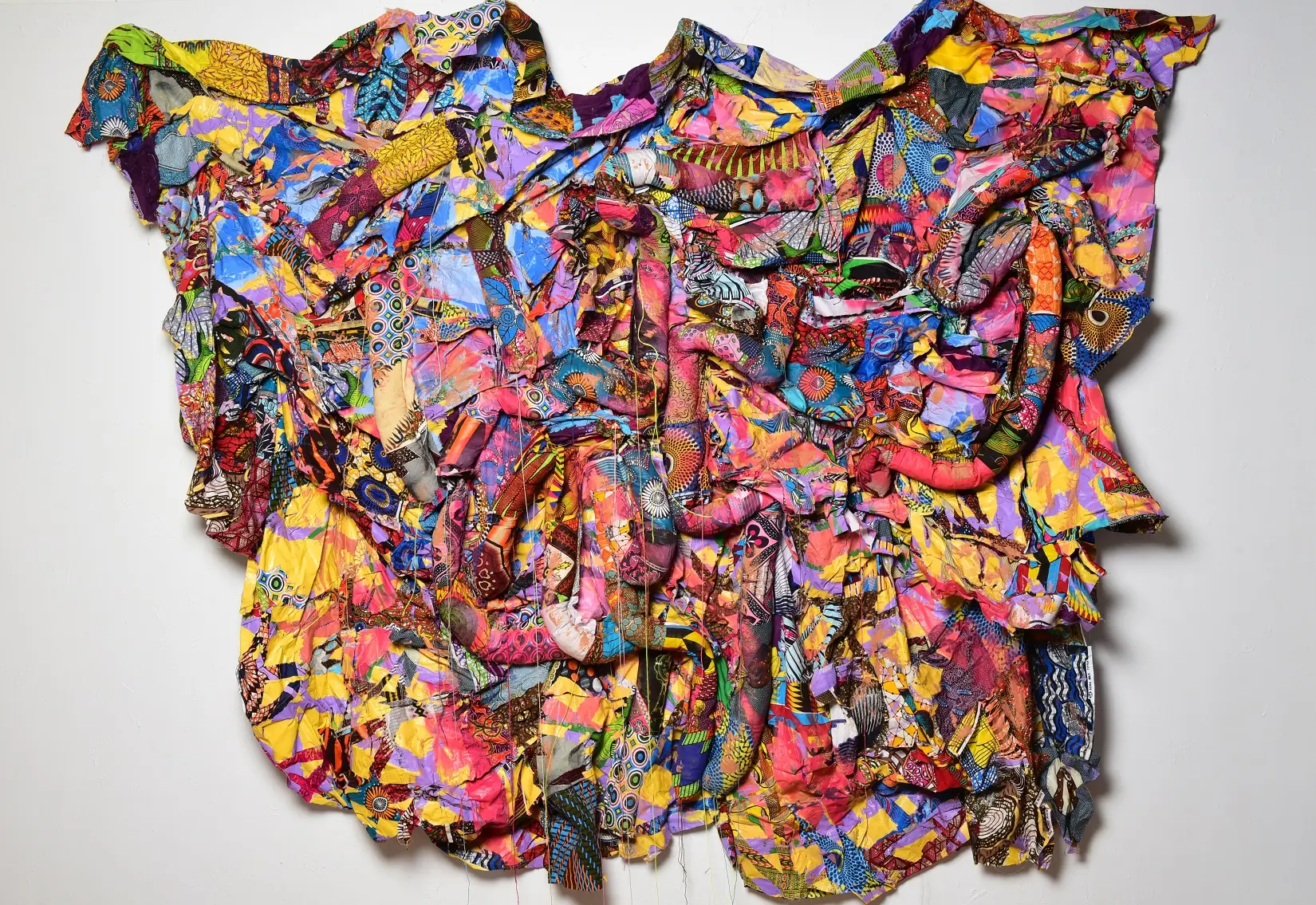
To incorporate both his American and African identities, Jamele works with Dutch wax print scraps. Like many, he believed the fabric had originated in Africa. But research later proved the textile originated in Holland and London. That discovery not only changed his perspective on the textile itself, but also its narrative.
‘The Dutch wax cloth was adopted by Africa, and I feel that is similar to being Black in America. The cloth is neither African nor Dutch. It’s something in between, like me.’
Jamele then slathers Georgia Red Clay onto the fabric strips. The clay from the state of Georgia (US) has a high mineral content that stains most any surface it touches. Georgia is also one of the US states that had the highest population of slaves before Emancipation.
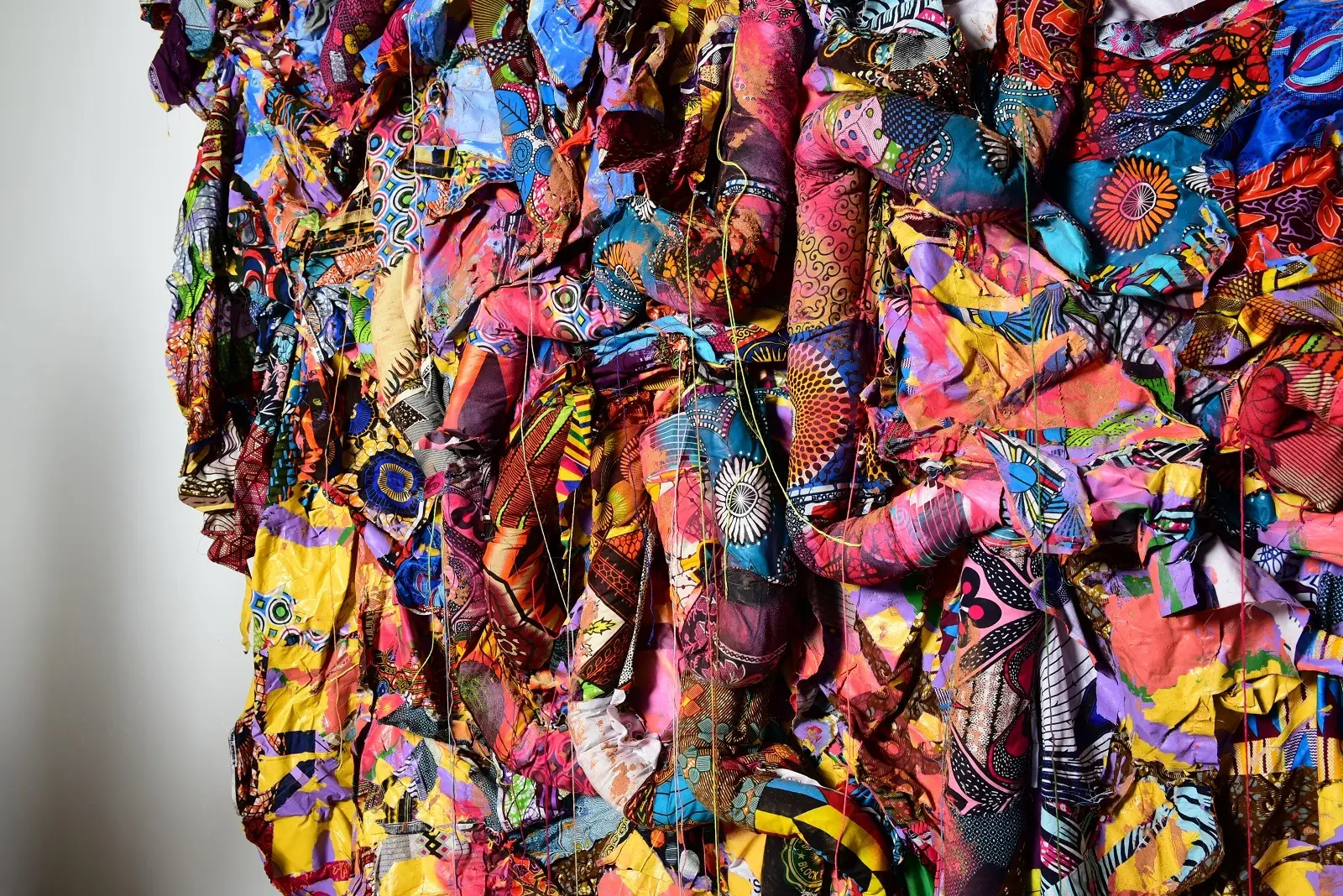
‘I feel like I’m putting my “stank” on the fabric and infusing the energy of the South. And because Georgia Red Clay is similar to the red clay of Africa, I want these pieces to create an imaginary land bridge from Atlanta, Georgia, to Africa.’
Jamele cuts and stacks the fabrics and then reaches blindly to start creating a piece. He will move pieces around if patterns are too similar, but he largely prefers the scraps come together organically. He then adds the red clay.
‘I like to be surprised in the process. I am not concerned with the perfect shape of the piece. I find the tension between beauty and distress by pushing both to the edge.’
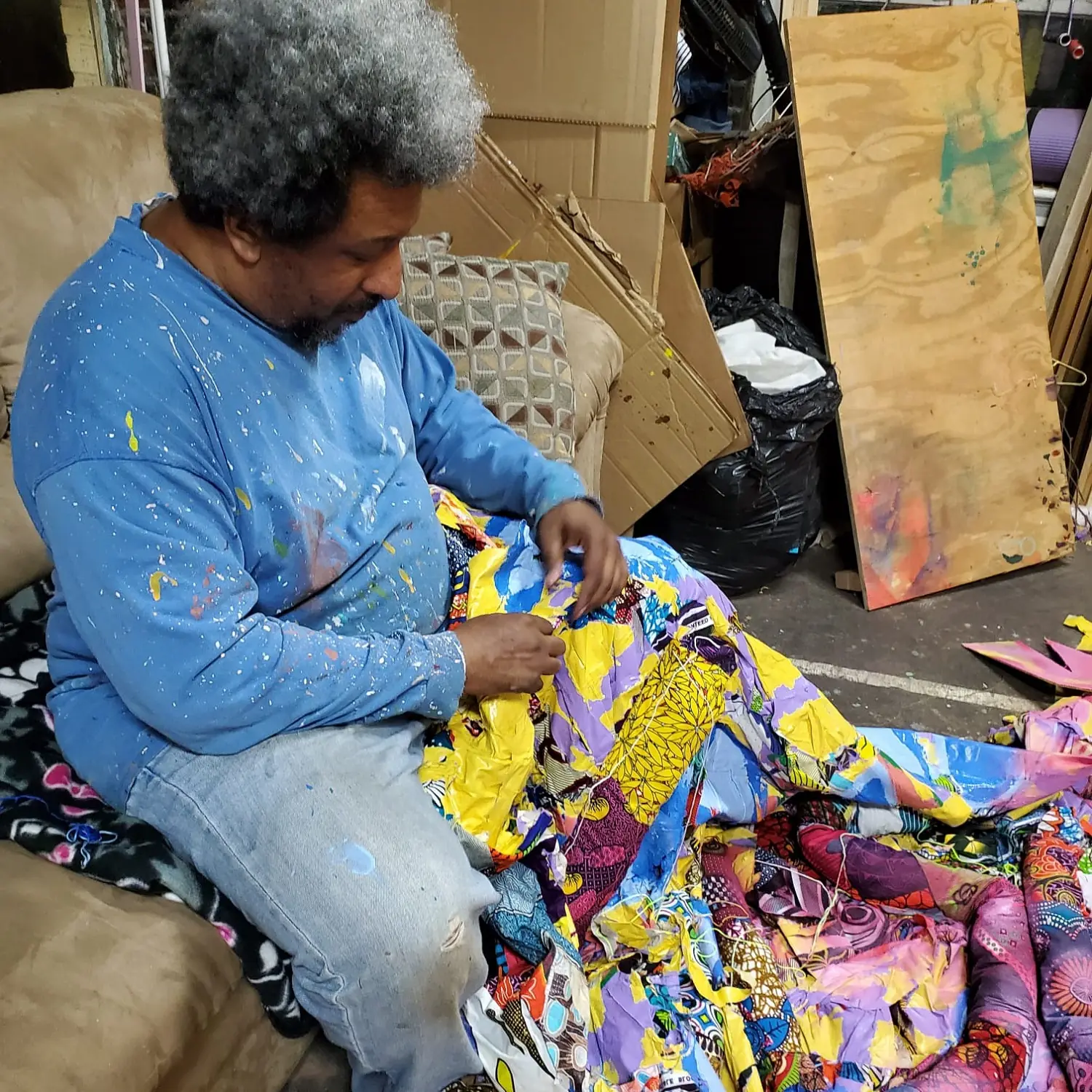
Jamele Wright, Sr., resides in Atlanta, Georgia (US). He earned a BA in Art History from Georgia State University and a Master of Fine Art from the School of Visual Arts in New York. He completed a fellowship at Project for Empty Spaces in Newark, NJ, and a residency at Hambridge Art Center in Rabun Gap, Georgia.
Instagram: @jamelewrightsr
Emily Felderman
Celebrating the line
Emily Felderman has a passion for lines and running stitch. She considers them to be ‘honest and forthright marks’. She also appreciates Harold in the children’s book Harold and the Purple Crayon who draws lines to create the adventures he desires.
‘Like Harold, I take my needle on a walk to create thousands of marks, ultimately overlaying an array of colours to create depth and dimension.’
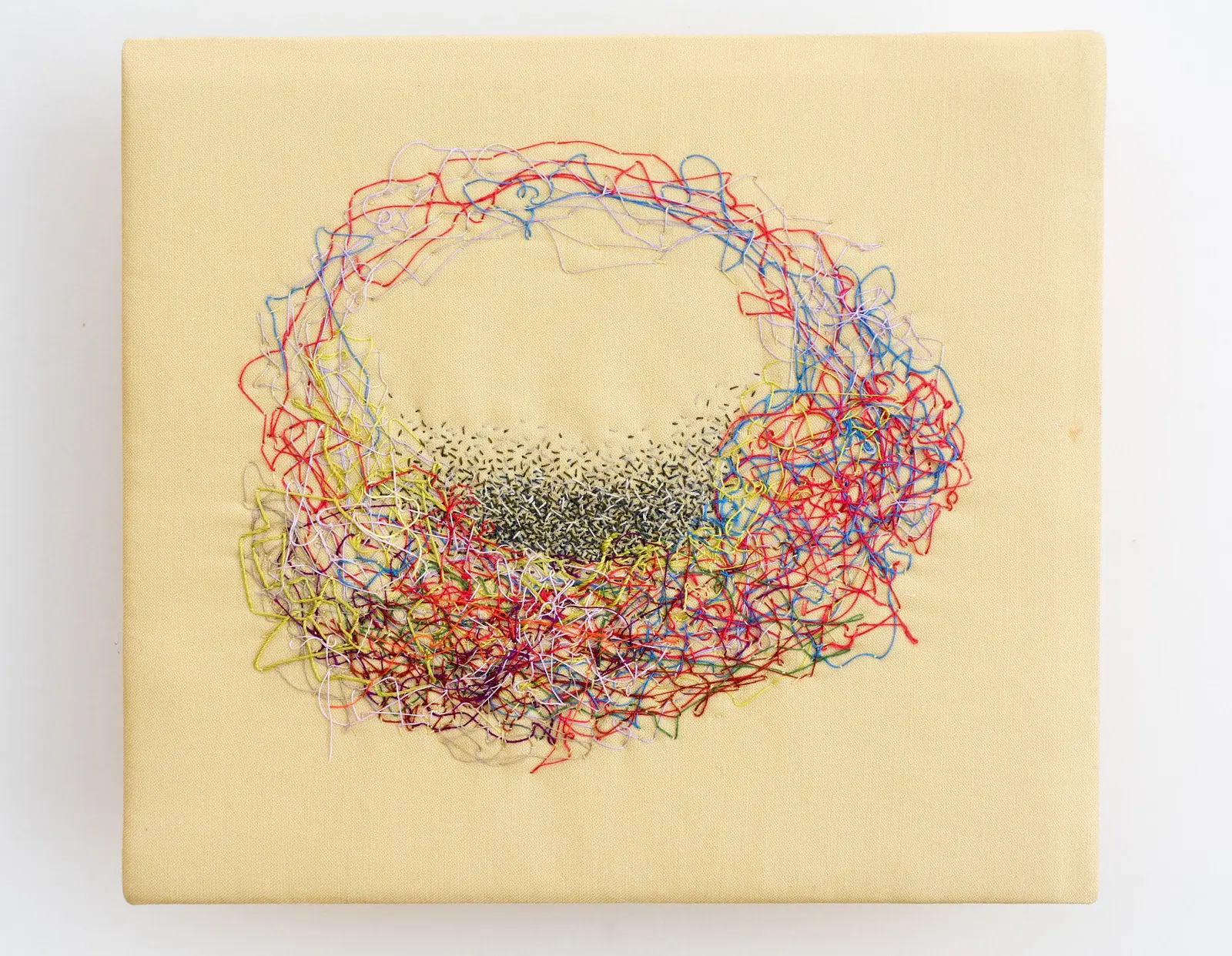
Emily is also inspired by nature’s colours and textures. Starting with a quick sketch, Emily pulls colours of threads together and considers what cloth to use. Once stitching begins, she allows herself to frequently change colour combinations and stitch lengths.
‘I pull thread through the tiny eye of a Milliners size 11 needle and commit many weeks and months to create one finished piece.’
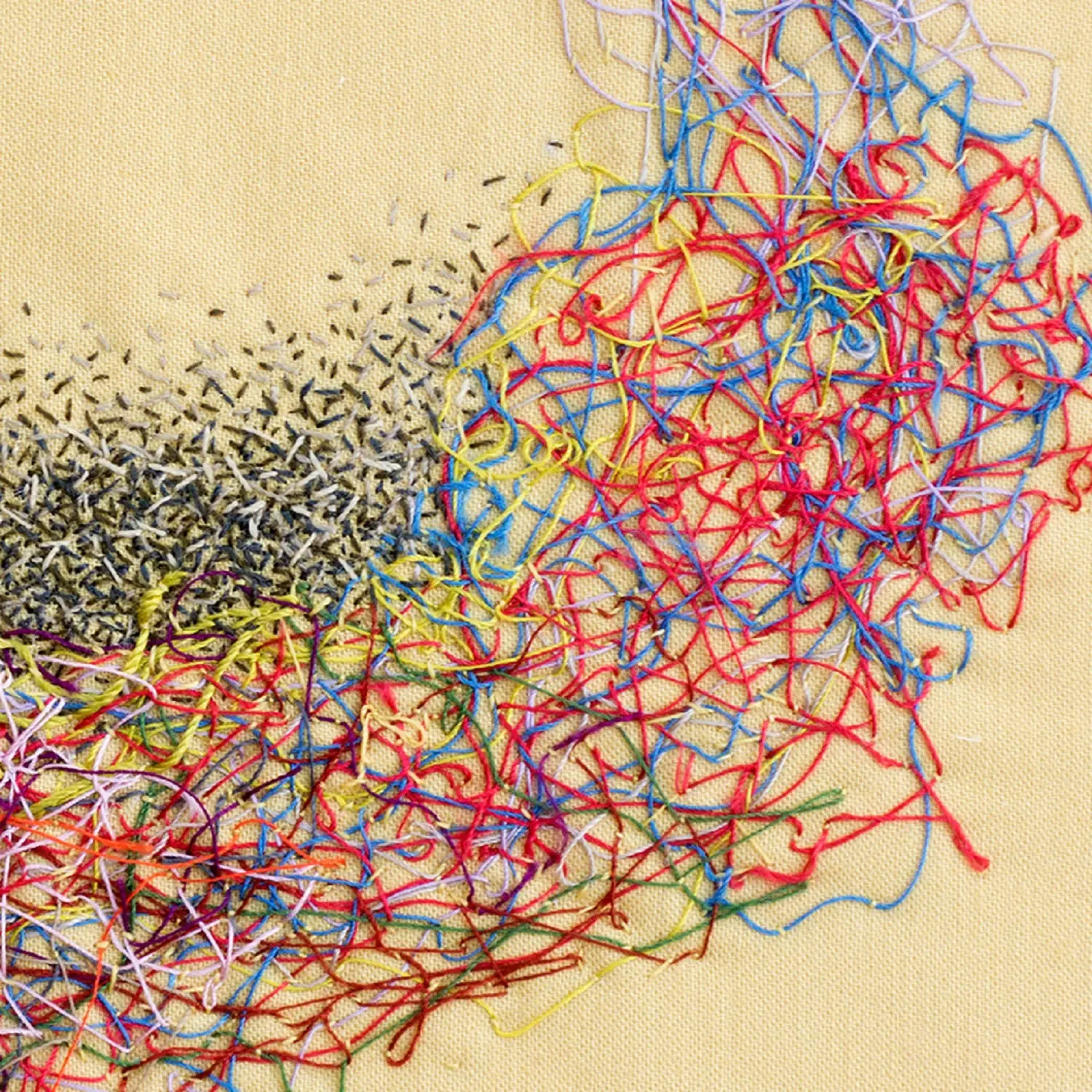
Emily prefers Gütermann threads, and she consistently uses the running stitch. She is also very precise in where each of her hundreds of stitches land.
For this piece, Emily created her twisty tangles by not pulling her thread flush with the fabric, leaving loops on the surface. Some of those loops were then caught with tiny stitches, and then the whole looping process was repeated, creating layers and layers of loops.
‘For me, stitching is meditative in moving the needle in and out of the fabric and pulling the thread through to create a stitch.’
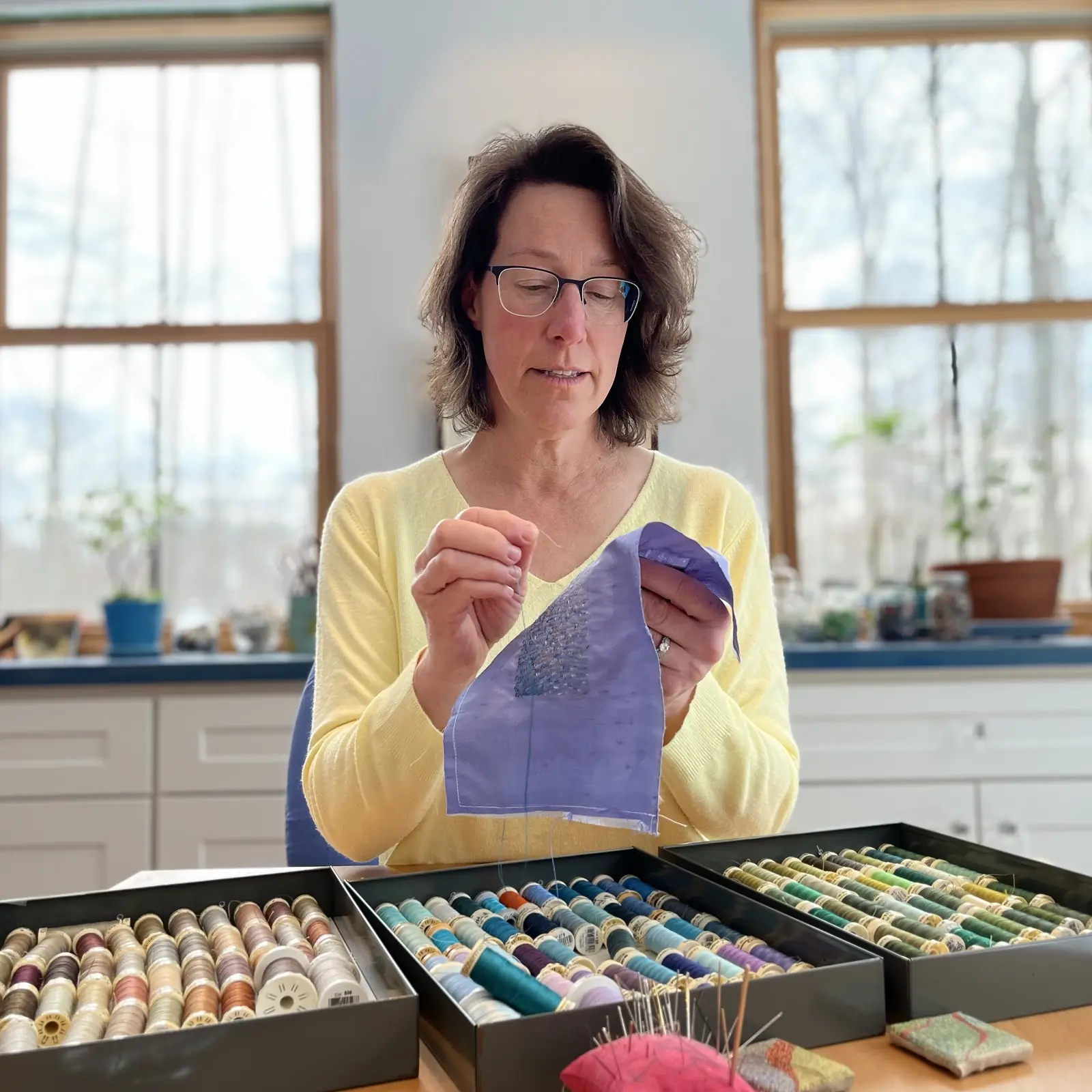
Emily was inspired by her grandmother to explore working with cloth. She has been teaching for 20 years, and her goal is to inspire students to believe in their creative abilities. Emily and her husband built their own home by hand over three and a half years, and it includes her ‘magical textile studio with beautiful windows’.
Website: emilyfelderman.com/
Instagram: @emilyfelderman
Richard McVetis
Sculptural stitching
Looking at Richard McVetis’s work, one can’t help but wonder ‘how did he make all those tiny stitches?’ Working with quilting cotton and wool flannel, Richard meticulously stitches multiples of embroidered dots and crosses. Seed and small straight stitches behave like ink on paper. And the result is remarkable.
‘I use a limited vocabulary of mark making and deliberately subdue the colour to create a binary simplicity. And most of the time, it’s not about the subject matter, but rather the act of making.’
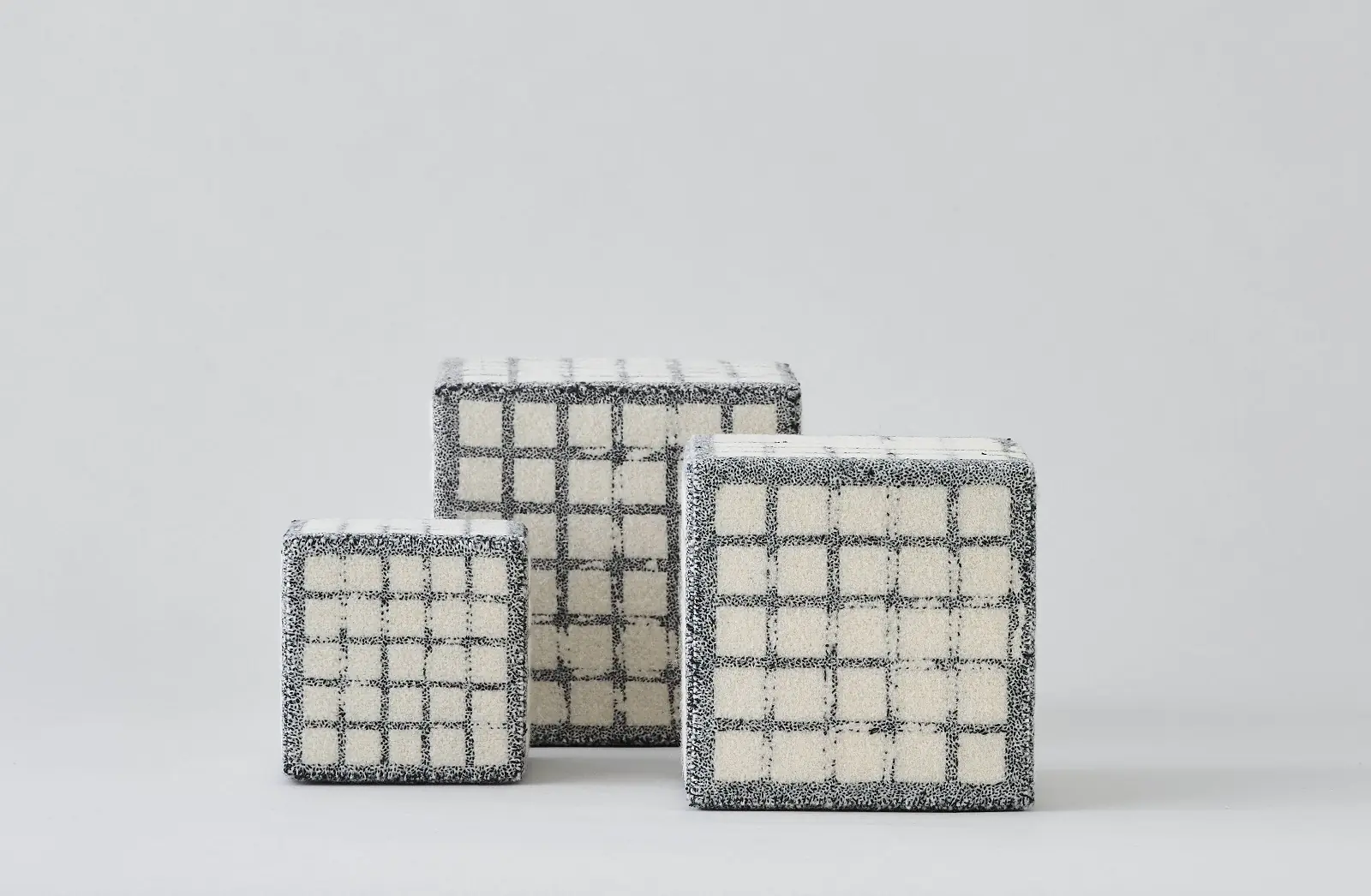
Richard describes his stitching as being records of time and maps of space. Each stitch is an embodiment of thought and patience and serves as a record of human presence, of time and decay.
The sculptural aspect of Richard’s Grid Collective work offers an especially unique way to witness these ideas. The combined stitchwork presents the tactile passage of time. And while each cube is meant to be considered individually, the grid gives the impression of uniformity, infinity and an attempt to control the uncontrollable.
‘There is a wonder in the majesty of the hand and its ability to create and make. I like the story the object can convey. Whether through materials or a memory of a place, the object is an important part of our culture.’
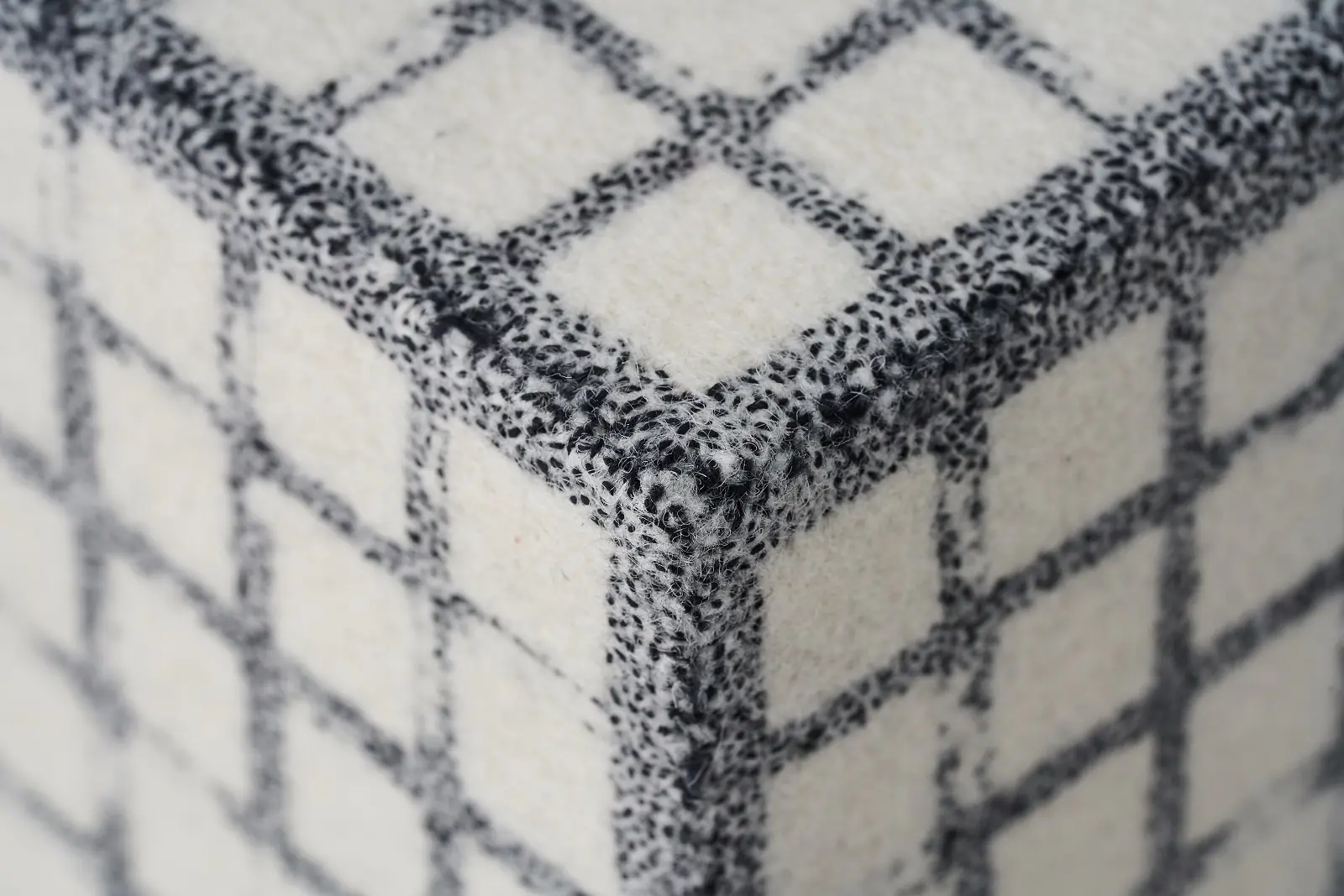
Richard has a particular love for collecting, arranging and rearranging objects, and that passion can be contagious. The way the boxes in this work are aligned and spaced apart indeed affects the viewer’s perception of time and space when viewed from different angles.
‘I find the way in which we interact with space and the built environment in our daily life is in effect one big performance sculpture.’
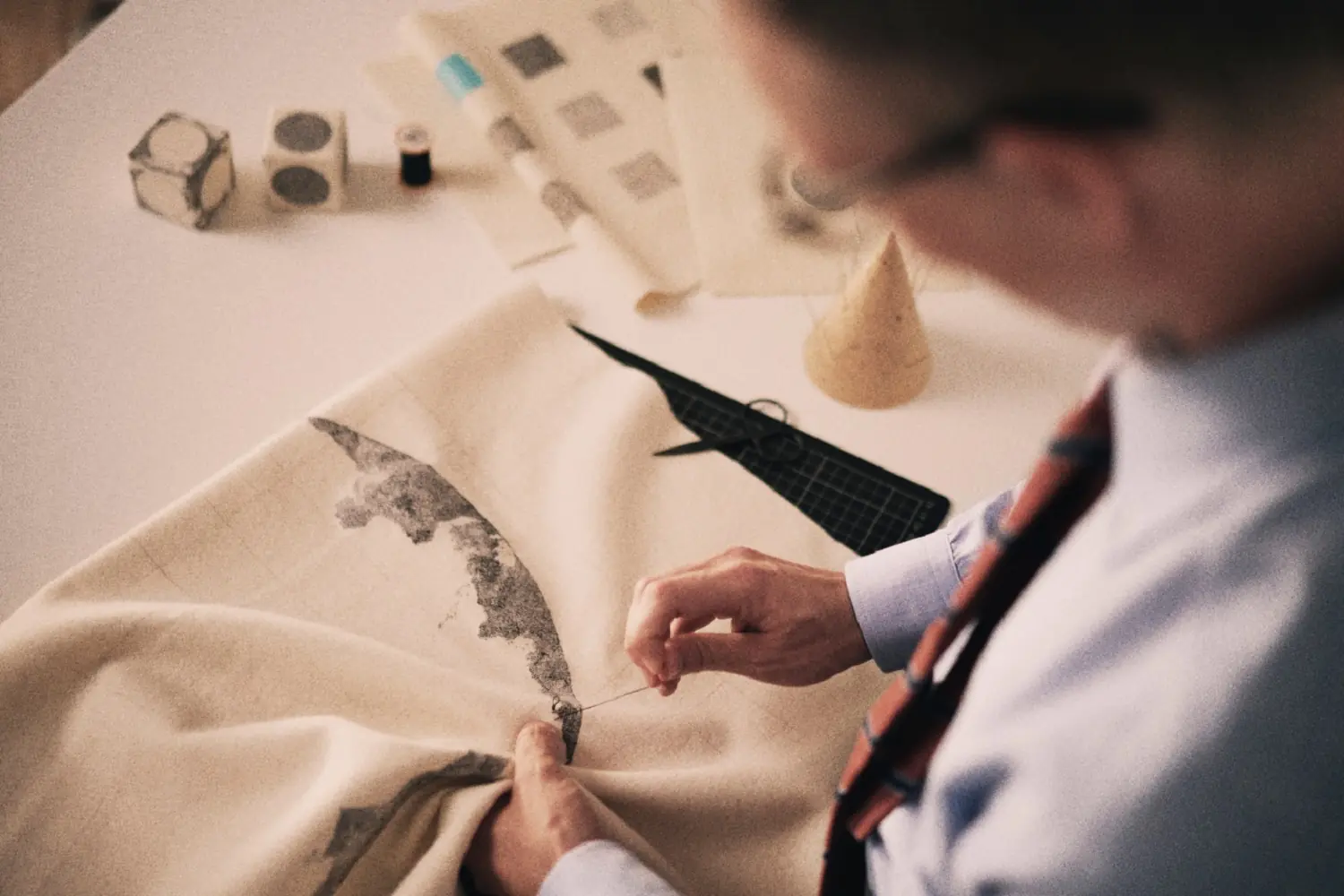
Richard McVetis is based in London. He graduated in Constructed Textiles from the Royal College of Art and completed a Bachelor of Arts in Embroidery at Manchester Metropolitan University. He has shown his work across the globe, including The British Textile Biennial (UK). And he has been shortlisted for several distinguished prizes, including the Jerwood Drawing Prize (UK).
Website: richardmcvetis.co.uk
Instagram: @richardmcvetis
Deidre Adams
Constructive destruction
Deidre Adams is an ‘excavator’ of sorts in her textile art world. And she is admittedly obsessed with building up layers of marks, scribbles, stitches, and fabric, only to cut into and otherwise tear them all apart.
‘I always love a process that involves both creation and destruction, building up and tearing down. My inspiration comes from surfaces that bear the marks of time and transformation.’
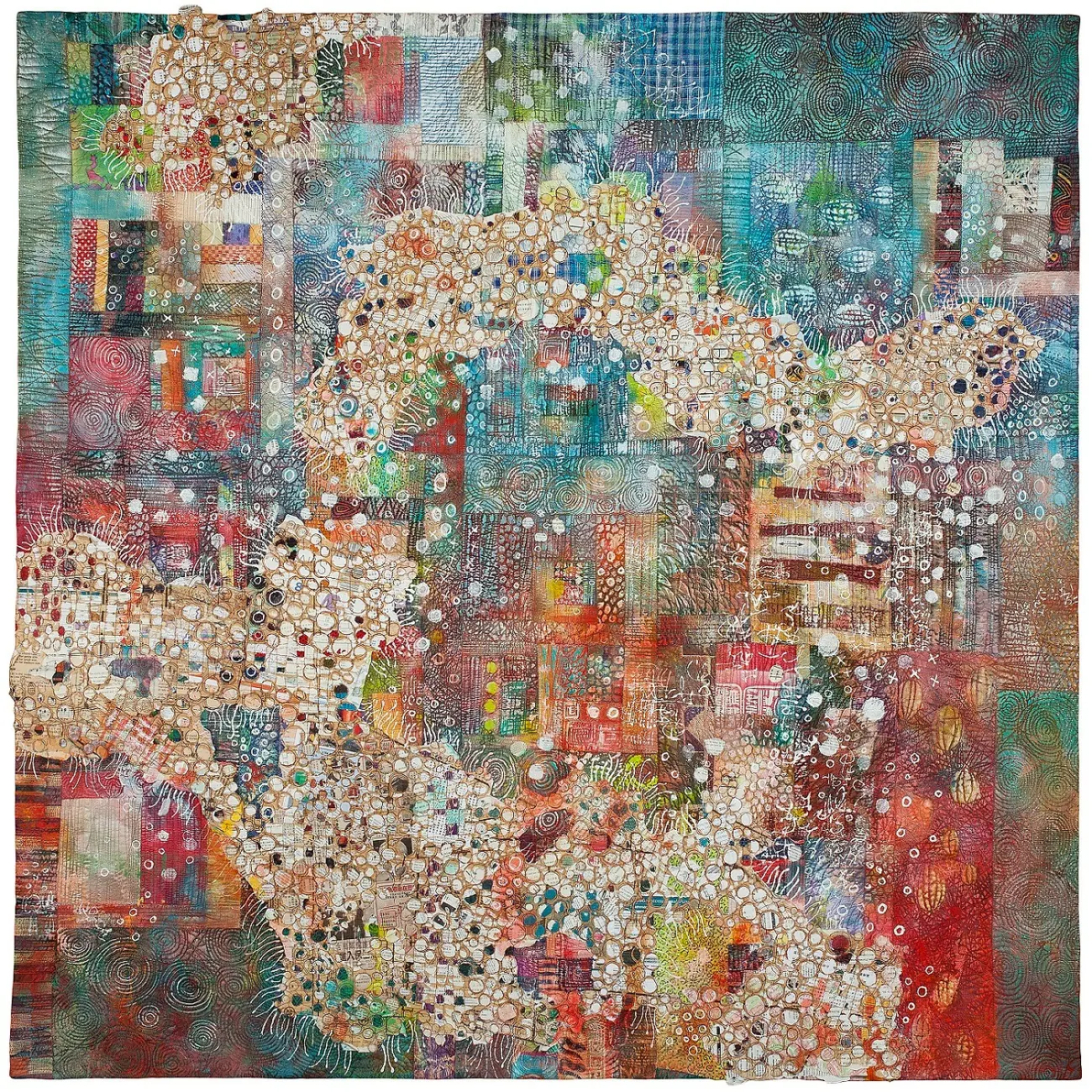
Upon close inspection, you’ll discover multiple quilted layers. The foundation layer is largely composed of fabrics pieced together with free-motion stitched designs. Acrylic paints were then applied to add colour and texture.
On top of that foundation lie isolated pieces cut from a separate quilt composed of layers of different papers, also intricately stitched together. This layer is where the ‘excavation’ magic lies. The white, ivory and brown areas of the work are where Deidre used an X-ACTO knife to cut into the paper surfaces and peel back the layers to reveal different underlying areas.
‘I’m inspired by photos of old peeling walls or floors where their layers are revealed. I’m intrigued by what lies beneath. Even news story cycles have layers of truth that are peeled back day by day, showing there is always more to something than first meets the eye.’
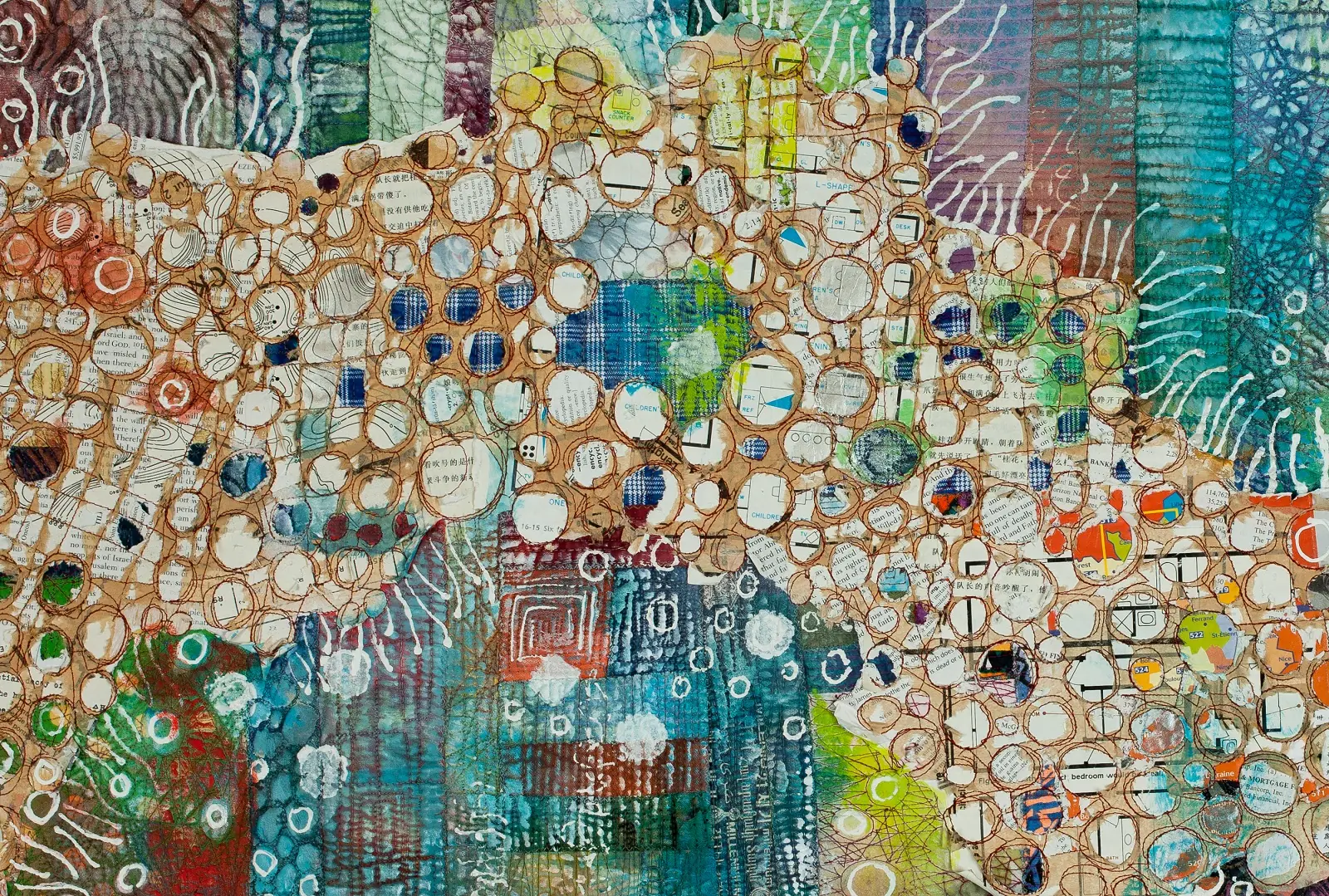
Deidre ascribes to artist Henri Matisse’s notion that ‘an artist is an explorer who has to begin by self-discovery and observation of his own procedure.’ Experimentation with materials and techniques is critical to her artistic growth.
‘On any given day, I may choose to work with fabric and stitch, and on another day, I might work with paper or paint. I think we become artists because it helps us discover who we are and find a strategy for living in a world that often doesn’t make sense.’
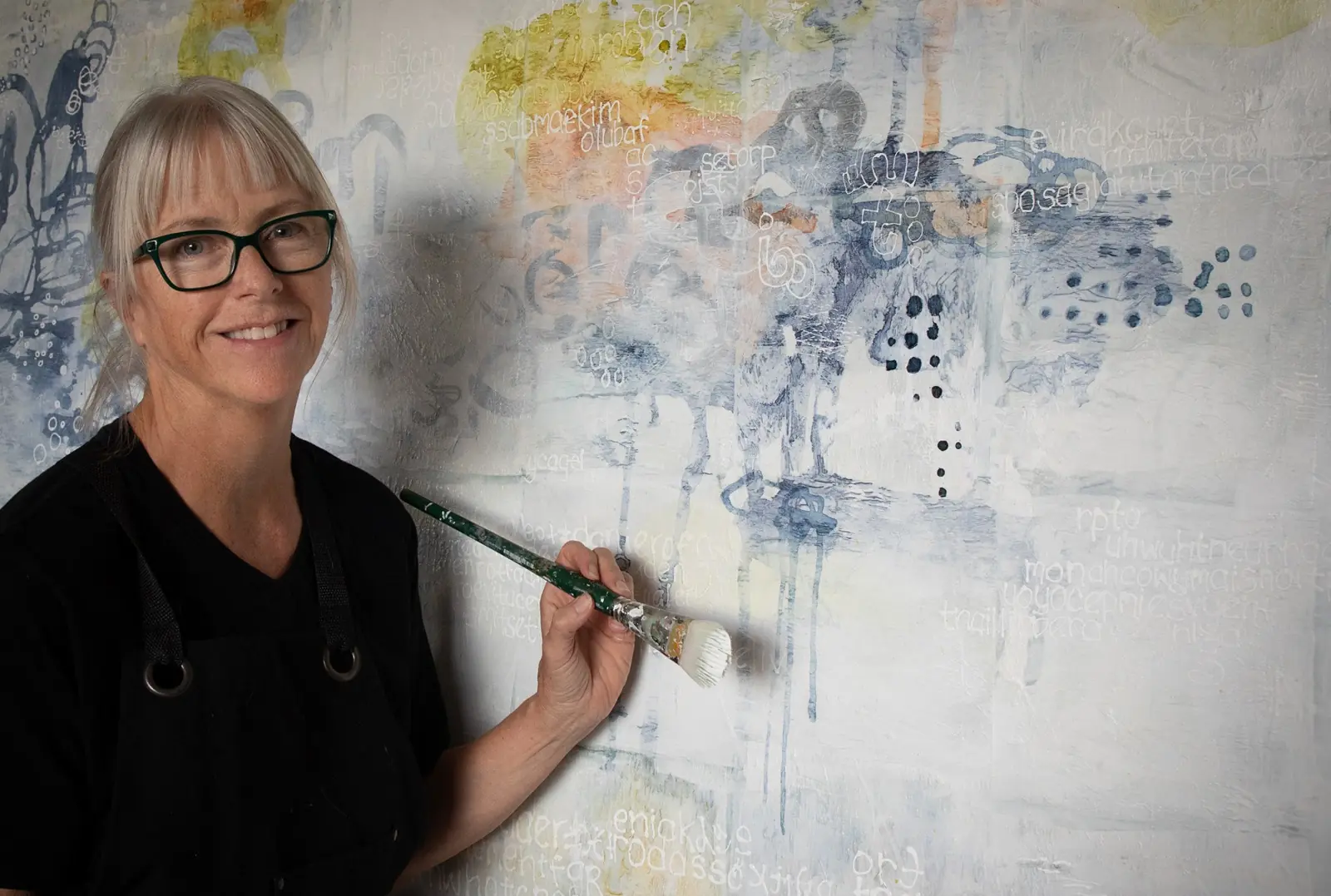
Deirdre lives in Denver, Colorado (US). She holds a Bachelor of Fine Arts from the Metropolitan State College of Denver, and her work has shown extensively in juried and invitational exhibitions and gallery shows. She is also represented in private, public and corporate collections, including the Wichita Center for the Arts (Kansas).
Website: deidreadams.com/
Instagram: @deidre.adams
Zipporah Camille Thompson
Ancestral creations
Zipporah Thompson’s work embraces her personal and ancestral mythologies and beliefs. Symbolic colours, archetypes and animism play key roles. She also juxtaposes materials and techniques to investigate hybrids, shapeshifters and abstractions in landscapes.
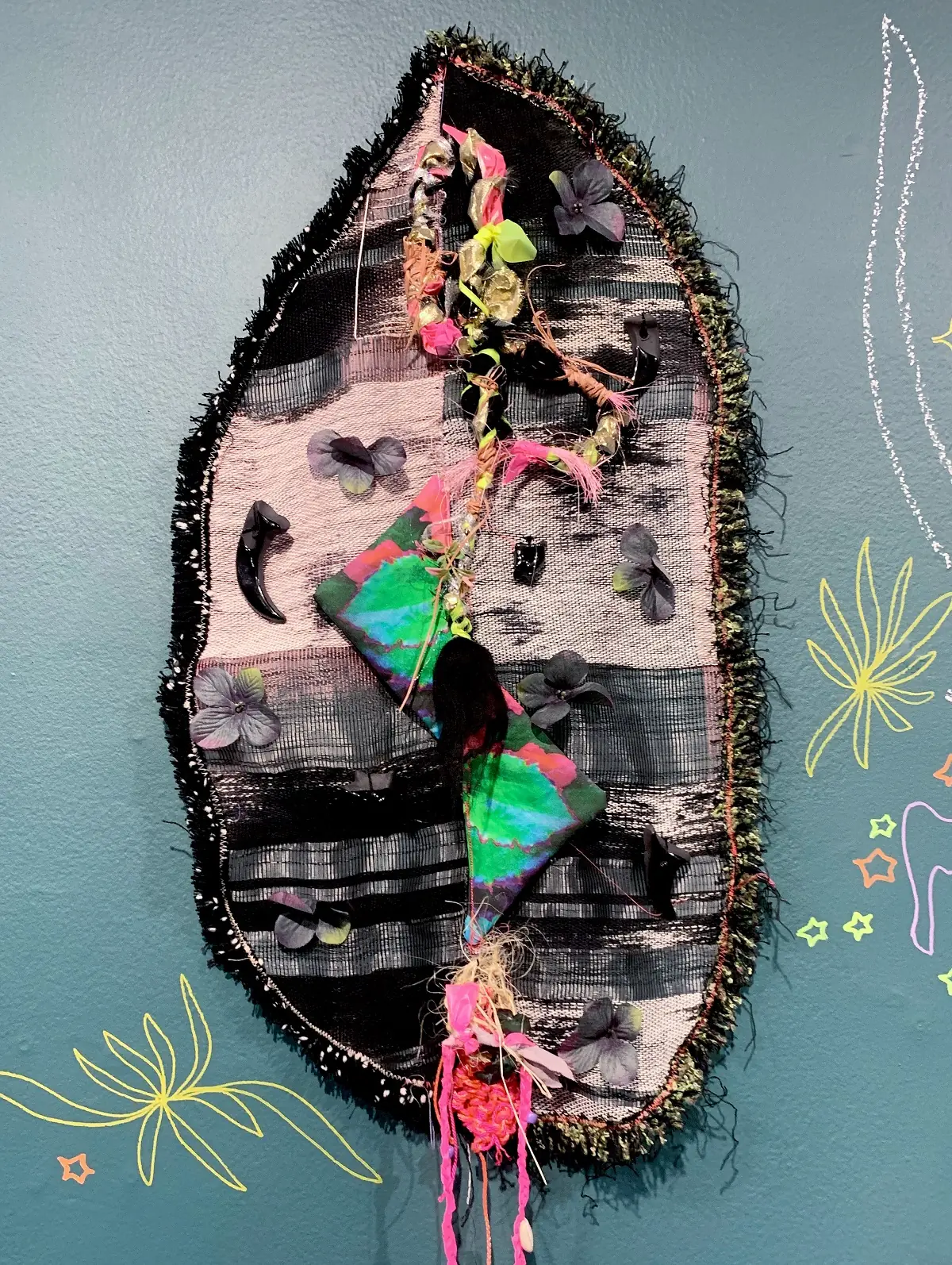
‘I celebrate the resilience of historically marginalised bodies. And my most cherished hues are the bluest eye of my grandmother and the seafoam “haint” blue of the Carolinas. I seek to create joyful spaces for those whose very existence has been excluded, denied or stolen.’
Zipporah’s works are glorious mashups of textile and treasure. But they also explore some hard realities: chrysalis is a testament to surviving personal trauma. Zipporah’s ‘emergence’ from those painful experiences is reflected by the organic shape and hand-woven patchwork echoing the ovular shapes of particular moon phases and the chrysalis state of a moth’s development.
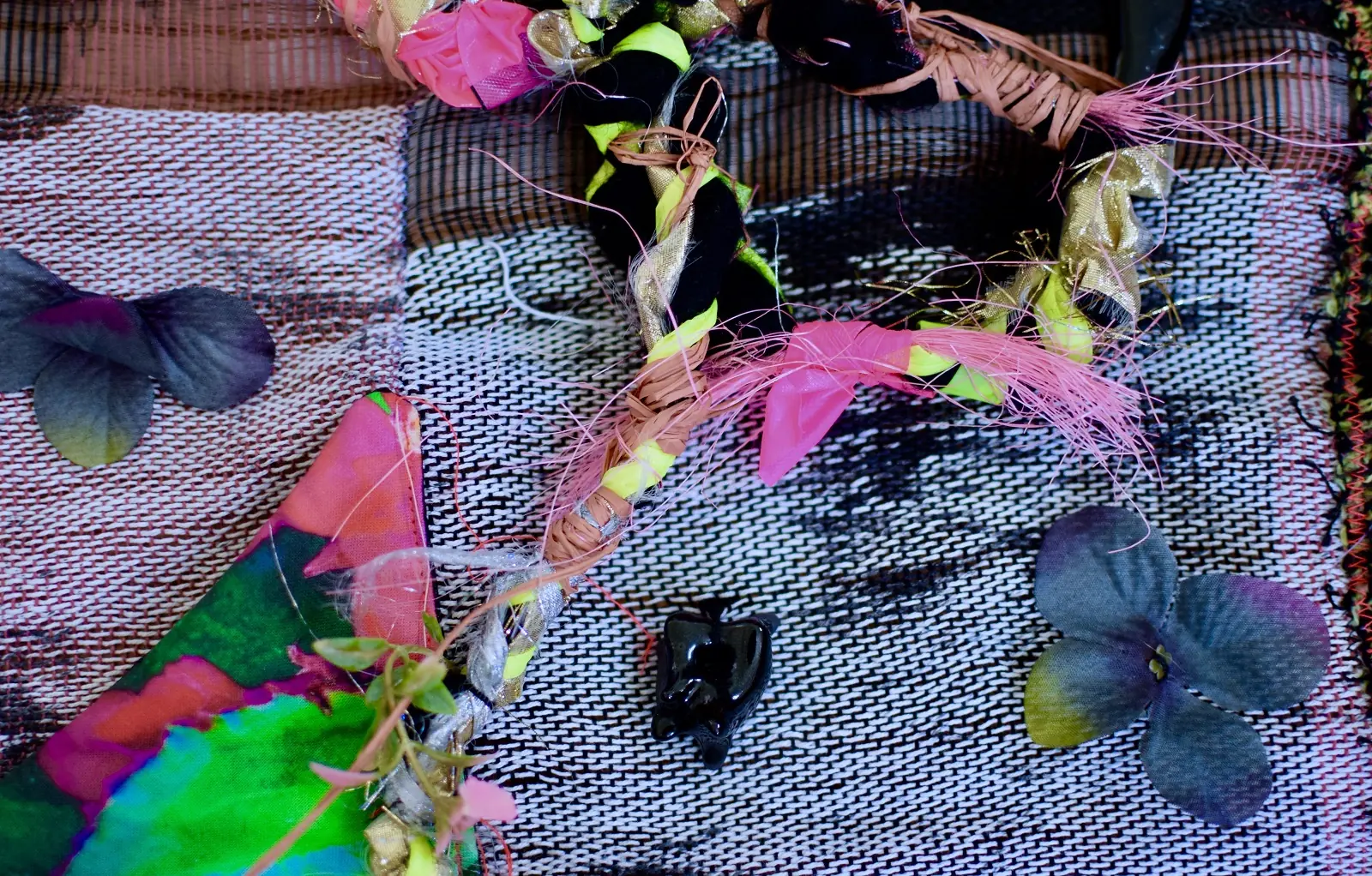
The work also features various found and created charms. Zipporah is a self-described ‘endless thrifter and alchemist’ who turns antique trash into treasure. And when it comes to surface design, she admittedly goes all out.
‘Just like my closet, the more colours, textures, and patterns, the better! I enjoy creating depth through interesting combinations of materials and surfaces: matte with shiny, woven with sewn, warm with cool, dark with fluorescent. I look for materials and surfaces that should not immediately go together.’
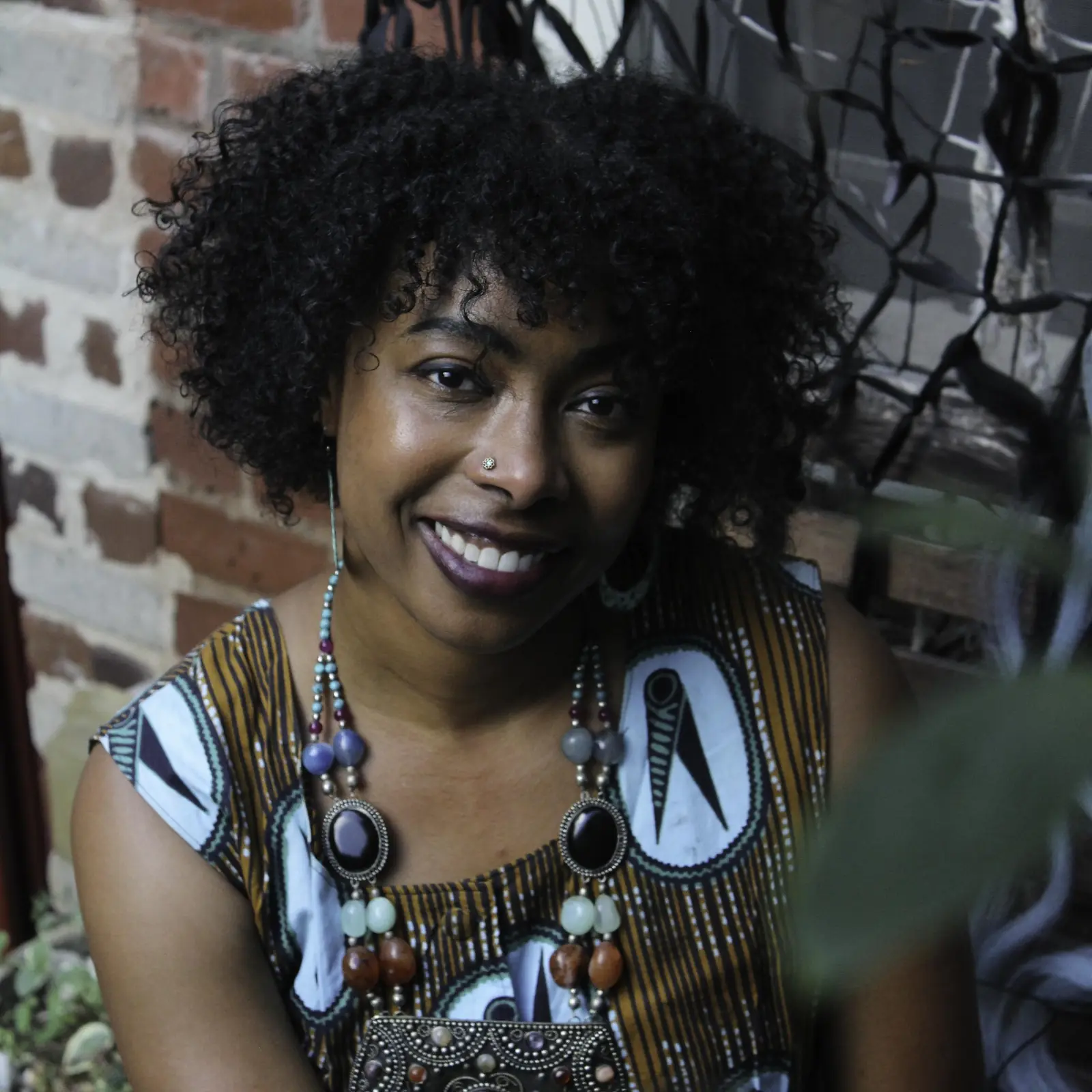
Zipporah Camille Thompson is originally from North Carolina (US) and now lives in Atlanta, Georgia (US). She received her Master of Fine Art from the University of Georgia and Bachelor of Fine Art from the University of North Carolina. Zipporah has exhibited at many venues, including the Zuckerman Museum of Art and Whitespace Gallery (Georgia). And she has been featured in several print and online publications.
Website: zipporahcamille.com
Instagram: @zipporahcamille
Harriett Chapman
Colourful simplicity
Wales-based artist Harriett Chapman is known for her use of bold colours and celebration of simple objects from everyday life. Teacups, jugs, table lamps, and even chairs are celebrated through her use of abstract sizing and placement.
‘I am interested in the history of objects and how familiar they feel when I see them. They represent a connection to people, places and specific times.’
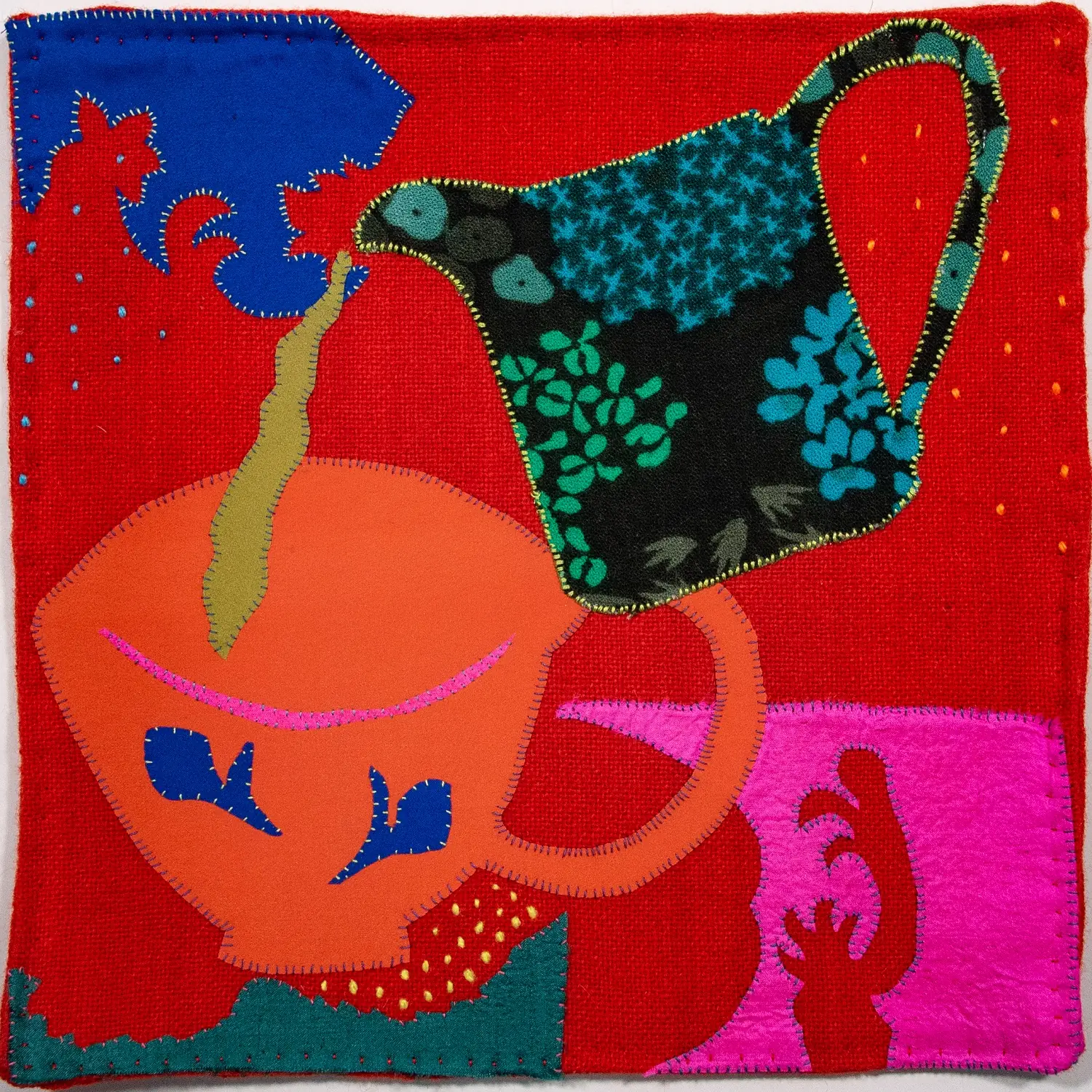
Harriett usually chooses a colour palette first and then simplifies the objects to be featured from their sources. Before cutting out her fabric shapes, Harriett strengthens her fabrics by using Bondaweb to fuse them to backing fabrics. She then cuts the shapes and appliqués them to the background using simple stitching in complementary and contrasting threads that help highlight the shapes.
‘I like to use fabrics from charity shops. The patterned 1960s fabric in this piece was a fantastic find. Its green and turquoise contrasts nicely with the red. And the pop of pink adds another delicious dimension to the piece.’
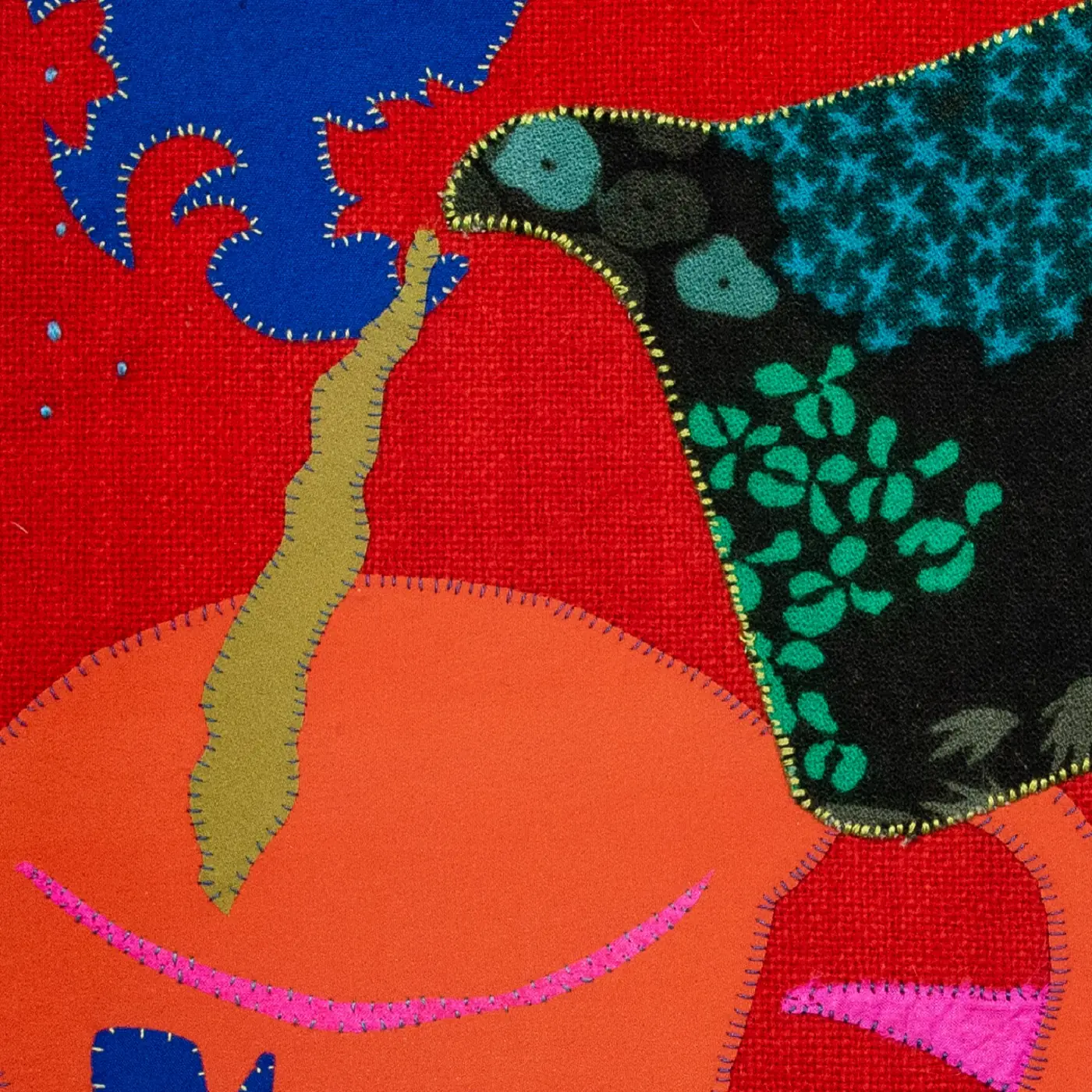
Harriett also plays with proportions in her work. She’s a fan of primitive folk art, which often features distorted use of size and placement within a composition. In this piece, Harriett has made the cup appear to be the same size as the jug.
‘I was taking inspiration from a very large cup I owned and had already cut out for a different work which was discarded for yet another project. I do this a lot. I have a bank of cut-out pieces I can turn to at any time.’
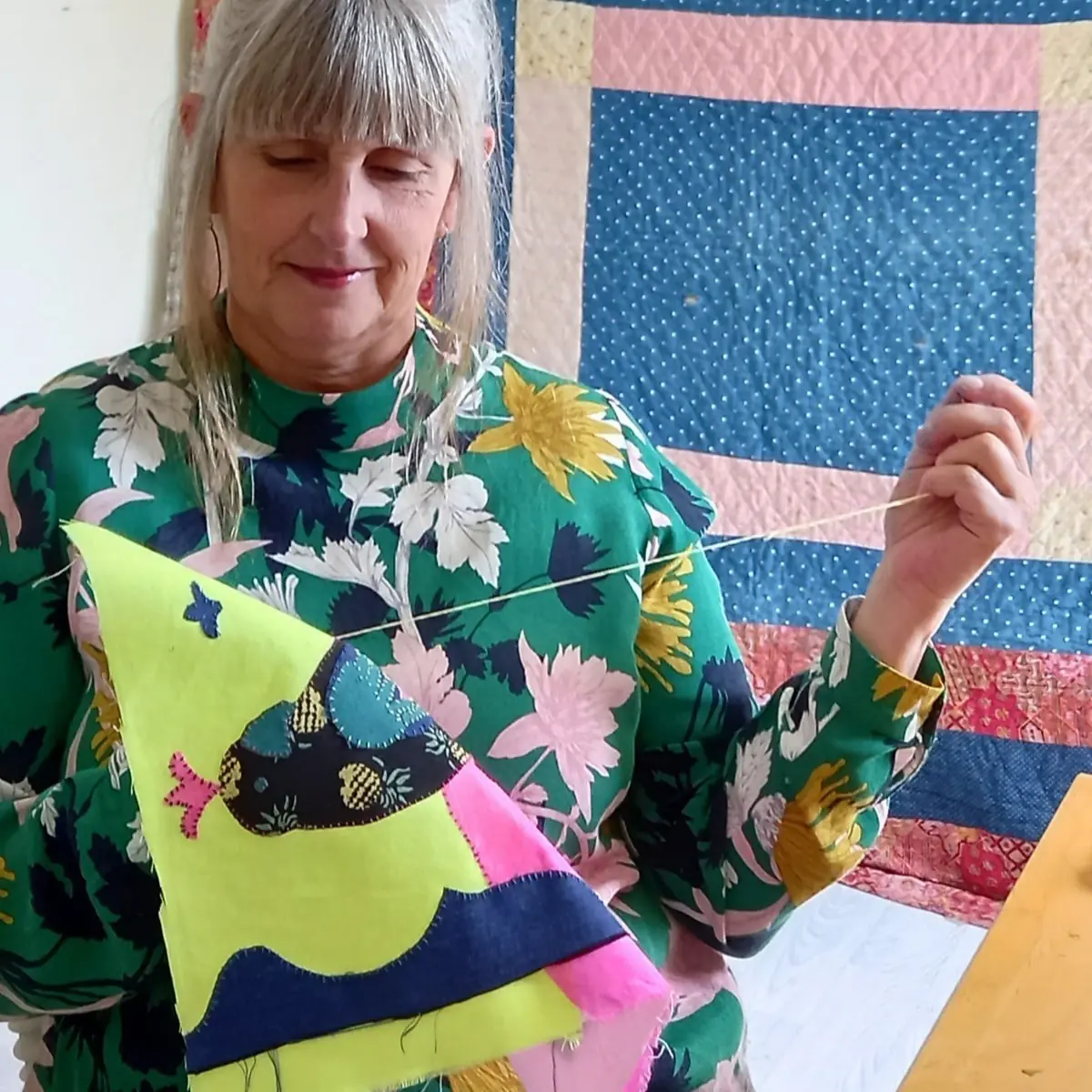
Harriett Chapman originally studied screen printing at the London College of Printing and later studied surface pattern design at Swansea College of Art. Upon graduation, Harriett started a business selling purses, bags and scarves using her digitally printed fabric designs. That business has grown alongside her own artistic evolution.
Website: harriettchapman.com
Instagram: @harriettchapmandesigns
Key takeways
- If you’re interested in creating your own abstract work, start small. Instead of trying to abstract an entire composition, start with just the background or a particular object, as Harriett Chapman explains.
- Key design elements that are ripe for abstraction are colour, line, shape and perspective. So, as Deidre Adams suggests, experiment with those elements using samples or other small activities.
- As in Zipporah’s work, think about juxtaposing or otherwise combining materials and techniques that might not intuitively play well together.
- Explore the possibility of creating 3-D works like Richard McVetis to help abstract an object’s size and dimension.
Wondering if creating abstract art is for you? ‘Dabbling’ is a great way to explore the possibilities. Check out this article on easy ways to explore and have fun without a huge commitment of time or materials.
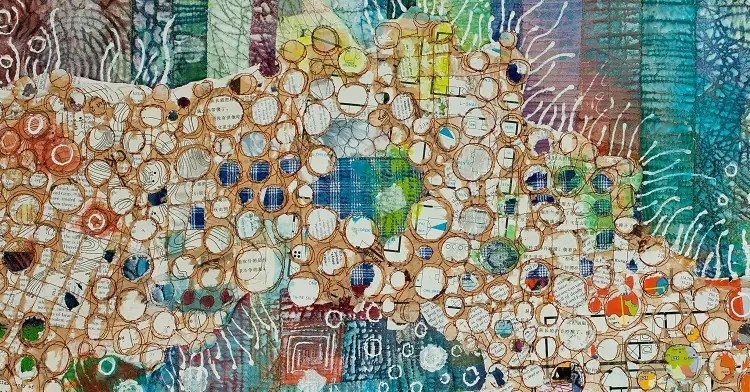

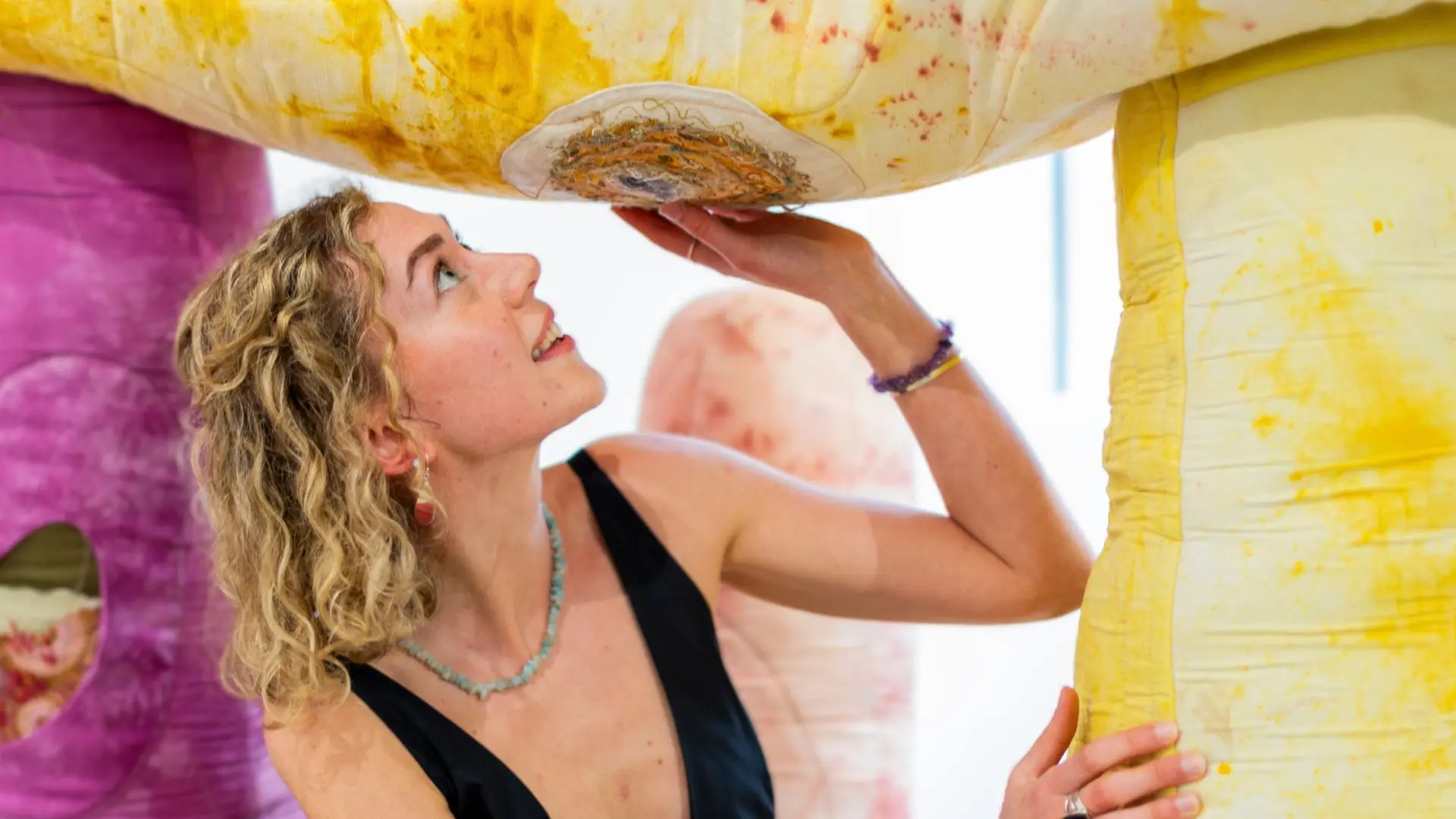
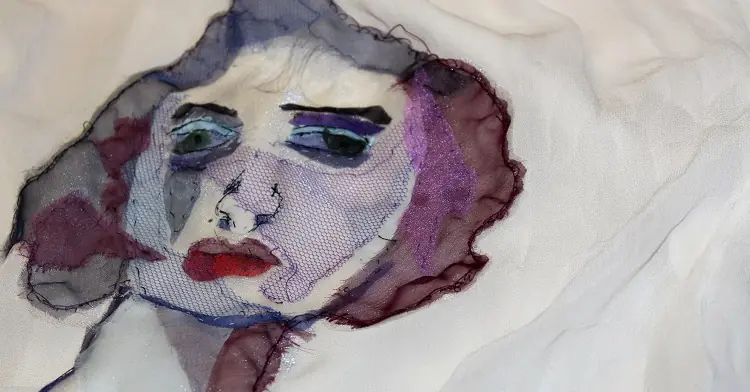
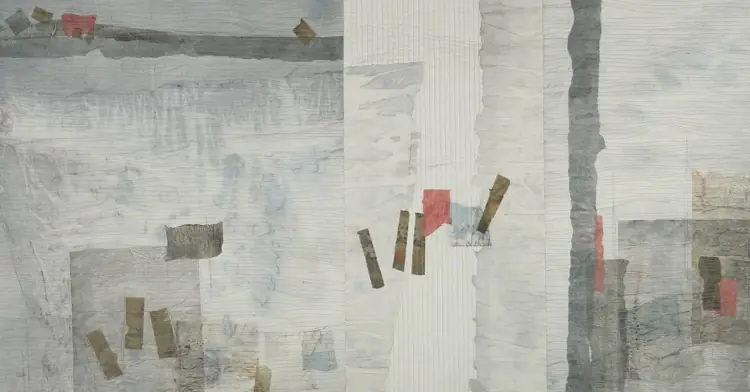
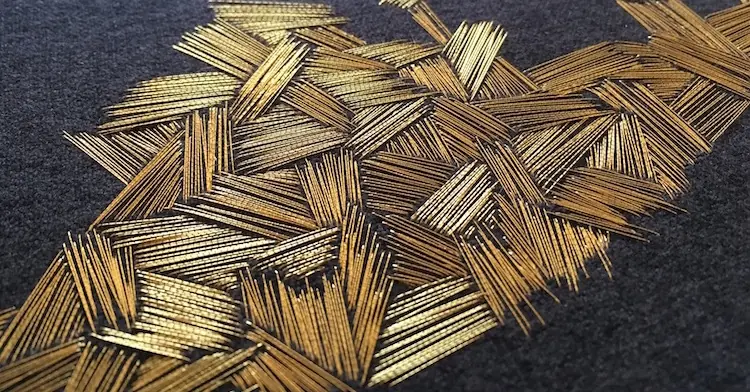
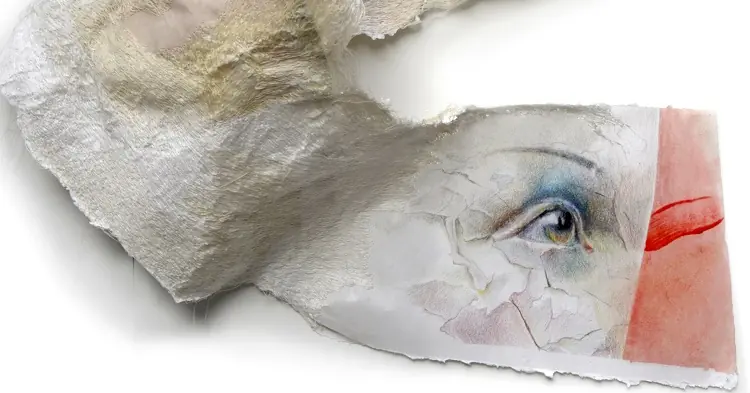
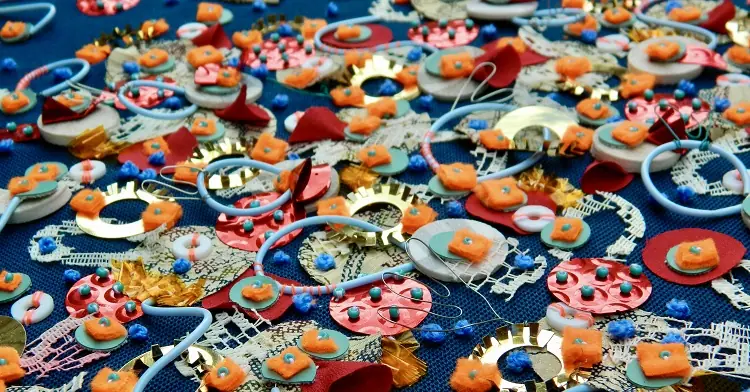
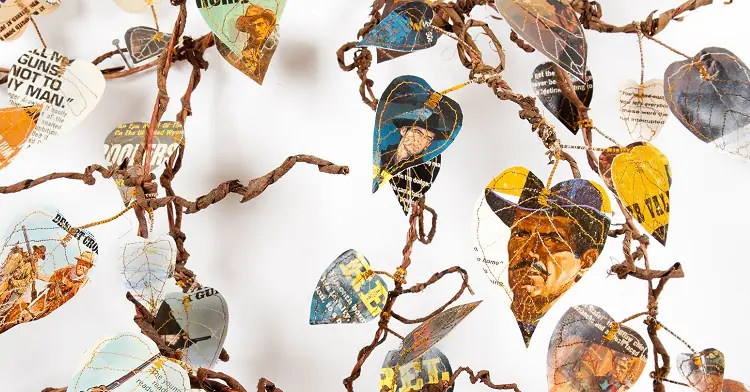
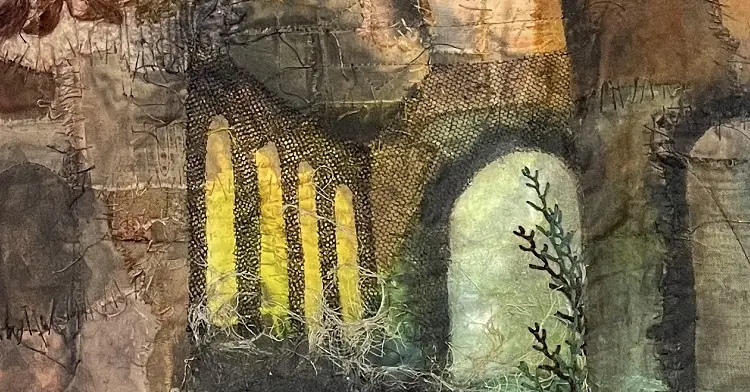
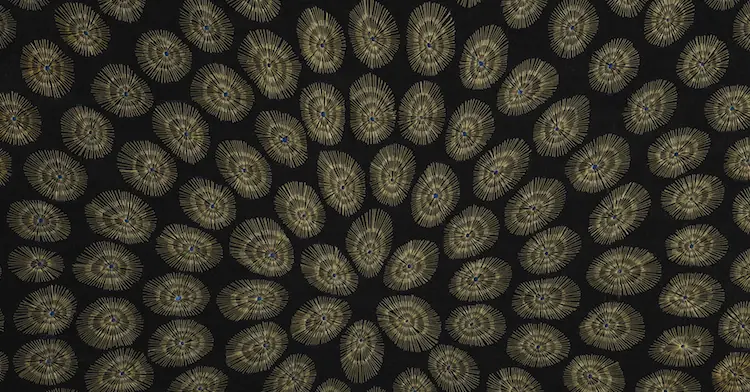
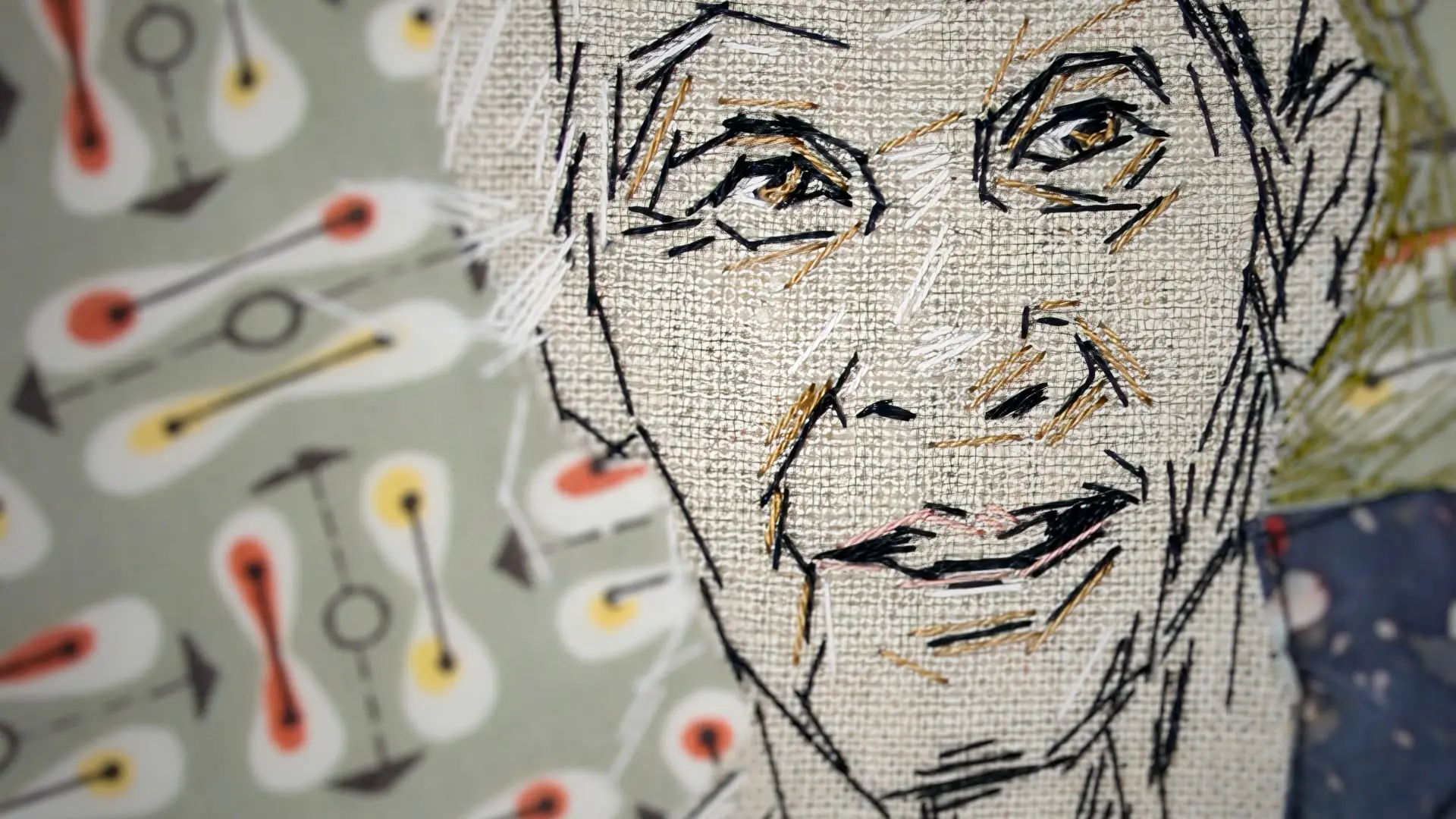
1 comment
K____H
I opened this sites because of my design project but when I finish reading everything I notice that this is very good artwork and it inspire me.